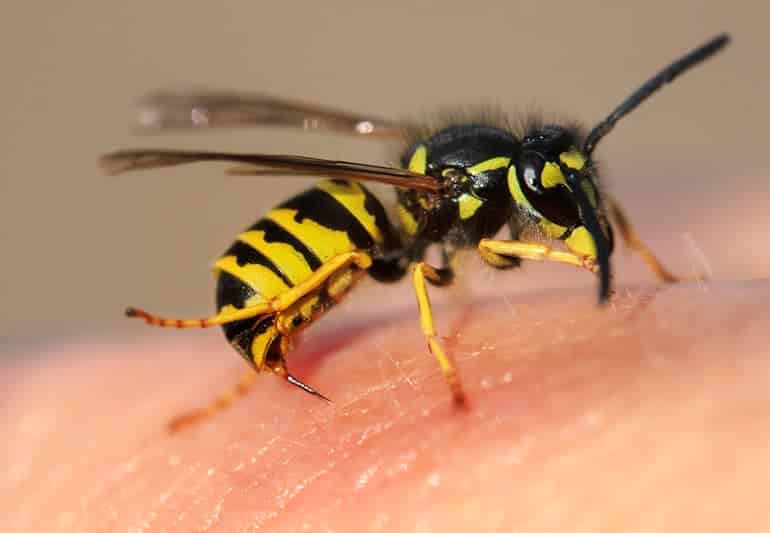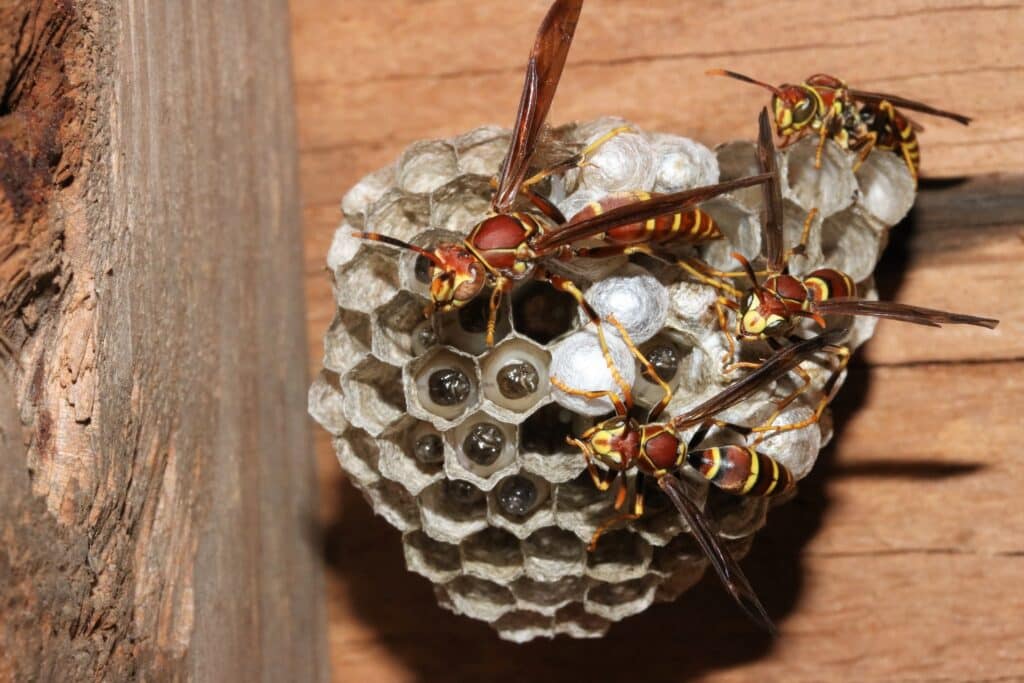Wasps are not only a nuisance should they invade your home, but they can also be dangerous. Unlike bees, a wasp can sting you many times because it does not lose its stinger.
Therefore, when you take into account the painful stings and just how annoying their presence is, getting rid of them is in your best interests.
A pest control service or chemical use can help eliminate wasps, but before resorting to these dire measures, why not try something simpler and readily available? Dish soap.
However, is dish soap effective against wasps? Find out below.
Can You Kill Wasps With Dish Soap?
Yes, you can kill wasps using dish soap, but it is less effective against aggressive wasps or large nests. This homemade remedy breaks down the wasps’ waxy exoskeleton, suffocating and ultimately killing them.
Dish soap is readily available and relatively inexpensive, making it an affordable option for pest control. Moreover, unlike some chemical pesticides, dish soap is generally safe for humans and pets if you use it properly. It doesn’t leave behind harmful residues that could pose a risk to people or animals.
Also, dish soap is biodegradable and doesn’t have long-lasting adverse environmental effects. In addition, the process of making the dish soap recipe for wasps is pretty straightforward; you don’t need any special expertise.
However, since soapy water doesn’t discriminate, you might harm beneficial insects while trying to kill wasps. Also, wasps can still return in the future since soapy water doesn’t provide ongoing protection against future wasp activity.
Furthermore, you shouldn’t use soapy water in sensitive areas like around bodies of water or plants that the soap could harm.
Related Posts:
- How To Get Rid Of Wasps Outside
- How To Get Rid Of Yellow Jackets
- How to kill a wasp in your house without getting stung
How Does Dish Soap Kill Wasps?
So, we know that dish soap kills wasps, but how exactly does it achieve that? It kills wasps through a combination of physical and chemical mechanisms that disrupt the insects’ physiology and behavior. Here’s how.
1. Exoskeleton Penetration
Like other insects, wasps have a protective exoskeleton that helps them retain moisture and protect their internal organs. This exoskeleton has a thin layer of wax that helps repel water.
Dish soap contains surfactants, which are compounds that reduce the surface tension of liquids and break down oils and fats. When you mix dish soap with water and spray it on the wasps, the soap molecules disrupt the waxy layer on their exoskeleton, reducing their water-repellent abilities.
This causes the wasps to lose buoyancy and become coated in soap, leading to suffocation and death.
2. Water Intake and Suffocation
The soapy water mixture has a lower surface tension, so the wasps’ exoskeleton can easily absorb it. As the soapy water gets absorbed, it interferes with the insects’ ability to regulate water and gas exchange through their exoskeleton.
Essentially, the soap disrupts wasps breathing and metabolic processes. Wasps rely on tiny tubes called tracheae for respiration, and the soapy solution can clog these tubes, leading to suffocation.
3. Disruption of Insect Physiology
The soap molecules can also disrupt the insects’ cell membranes and interfere with various physiological processes. This further weakens the wasps and contributes to their eventual demise.
4. Immobilization
Soapy water doesn’t kill wasps instantly but immobilizes them and reduces their ability to fly or sting effectively. This gives you the ideal situation to safely deal with them since the wasps cannot attack you when immobilized.
How To Kill Wasps With Dish Soap
Here is a step-by-step guide for killing wasps using dish soap. This section contains the materials and instructions to eliminate the wasps successfully.
Materials
- Liquid dish soap (Don’t use soap with additives or added fragrances)
- Water
- Spray bottle
Instructions
1. Prepare the Solution
Pour water into an empty spray bottle, leaving some space for the dish soap, then gently pour the liquid dish soap into the spray bottle with the water. Remember that getting the correct ratio is important. Typically, 2-3 tablespoons of dish soap go into a gallon of water, but you can adjust the ratio based on your specific needs.
Swirl the spray bottle gently to mix the water and dish soap. However, don’t shake too vigorously to prevent excessive foaming.
2. Choose the Right Application Time
The safety and the effectiveness of the process greatly depend on the application time, so choose wisely. Pick a time when wasps are generally less active, usually late evening or early morning.
Administer the soapy water solution early in the morning, as the wasps are relatively inactive during these hours. This is because they are still cold from the night and haven’t warmed up enough to become highly active.
Also, like early mornings, wasps tend to be less active in the late evening as they begin to settle down for the night.
3. Wear Protective Clothing
Despite choosing the appropriate application time, protective clothing will protect you further, so don’t skip this step. This is what you will need.
- Long-Sleeved Clothing: Minimize the parts of your body exposed to stings by wearing a long-sleeved shirt or jacket to cover your arms.
- Long Pants: Protect your legs by wearing long pants and tucking the pants into socks or boots to prevent wasps from getting inside your clothing.
- Closed-Toe Shoes: Wear closed-toe shoes, preferably with thick soles. This will protect your feet from accidental stings and any wasps on the ground.
- Gloves: Thick, fitting gloves, ideally leather or heavy-duty gloves, will protect your hands while also maintaining dexterity while using tools or handling the spray bottle.
- Hat with Netting: If possible, wear a hat with a netting or veil attached to protect your head and neck.
- Protective Eyewear: Wear safety goggles or protective eyewear to safeguard your eyes from potential stings.
- Face Mask: A face mask can be a suitable substitute for a hat with netting. It will ensure airborne wasps don’t get to your mouth and nose.
- Light-Colored Clothing: Since dark colors attract wasps more than bright ones, put on light-colored clothes.
4. Locate the Nest
You must know where to spray the dish soap solution for it to be effective. This means knowing where the wasps are and targeting these areas. So, spend some time observing the movement of the wasps, watching where they are flying from and returning to. This will give you clues about the location of their nest.
Follow their flight paths to see if you can determine the general direction of their nest. This will help since wasps typically have a direct flight path from their nest to foraging areas. Also, check the exterior of your home, garage, sheds, or nearby trees for any signs of wasp activity.
Furthermore, check for small openings or crevices where wasps might enter and exit because these insects often build their nests near these points. Also, examine both ground level and elevated areas since wasp nests can be at varying heights.
Moreover, pay attention to any wasp buzzing.
5. Spray the Nest
Approach the nest cautiously with slow and deliberate movements while keeping a safe distance to avoid agitating the wasps. Coat the wasps’ nests with the dawn soap solution, focusing on the entrance, the areas where wasps are most active, and the wasps themselves.
6. Observe and Repeat
After spraying the nest and the waps, move away to a safe distance, then give the soapy water solution some time to take effect on the wasps. You might notice some wasps becoming sluggish or falling to the ground. It will take time for wasps to be incapacitated and fail to fly once they get coated with soapy water, so be patient.
7. Dispose of the Nest
Remove and dispose of the nest once the wasps are immobilized or dead. Gently and carefully detach the wasp nest from its attachment point, ensuring you do it cautiously so you do not disturb any remaining live wasps or provoke any unexpected reactions.
Place the nest inside a sturdy plastic bag, then seal it tightly to prevent any wasps or other insects from escaping. Consider double-bagging the nest by placing the sealed bag inside another sealed bag to be sure the bag doesn’t break, or the contents leak.
Place the sealed bag inside an outdoor trash bin with a lid. After that, remove your gloves and wash your hands thoroughly with soap and water, then carefully clean the area to remove any debris or residue left from the nest that could attract other pests.
8. Adopt Preventative Measures
As mentioned, dish soap won’t prevent wasps from returning, so you must take strategies to keep your home wasp-free. These include eliminating food sources by cleaning food debris, sealing garbage cans tightly, regularly disposing trash, and promptly cleaning up spilled food and beverages.
Also, inspect your home for gaps, cracks, and openings that could serve as wasps’ entry points, then seal these openings with caulk or other appropriate materials. Moreover, regularly inspect your property for nesting sites, such as under eaves, gutters, or other protected areas, and remove them.
Furthermore, keep shrubs, bushes, and trees trimmed, consider planting natural repellents like mint, eucalyptus, or marigolds around your outdoor spaces, or set up commercial wasp traps.
Final Remarks
Wasps no longer have to be a nuisance when you have dish soap at home. It is effective, safer, environmentally friendly, and cheap. However, its effectiveness depends on the correct application, the right application time, and the severity of the infestation.

I’m Mike Hyle, an exterminator with 7+ years of experience handling all sorts of pests, including mice, cockroaches, bed bugs, and termites. I also write for Pest Solutions DIY blog to share my knowledge and help homeowners keep their homes pest-free. Outside work, I enjoy hunting, snowshoeing, and exploring nature. Check out my blog for helpful pest control tips!


